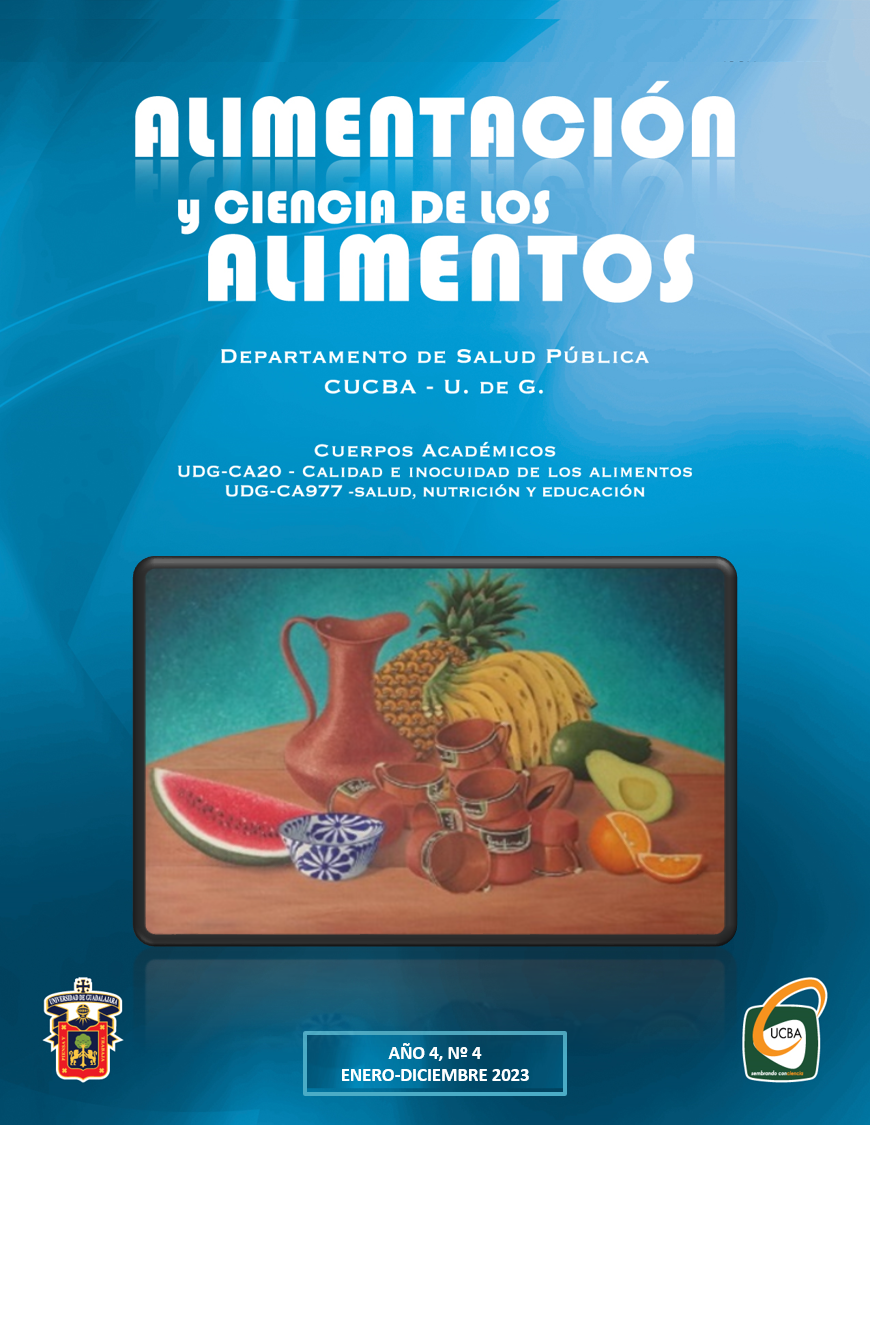Determinación del cociente de peligrosidad de plaguicidas presentes en biomasa de chiles (capsicum annuum)
DOI:
https://doi.org/10.32870/rayca.v4i4.26Palabras clave:
Capsicum annuum, plaguicidas, biomasa agrícola, fitoquímicos, valorizaciónResumen
El estado de Sinaloa, es uno de los mayores productores agrícolas en México, resaltando el cultivo de chile por sus volúmenes y rendimientos de producción. Debido a la producción intensiva se desprenden importantes cantidades de biomasa (tallos y hojas) los cuales comúnmente se descartan sin generar valor agregado, por lo que, en años recientes, estrategias de valorización sugieren su uso como fuente de nutracéuticos y fitoquímicos, sin embargo, si las biomasas se encuentran contaminadas con residuos de plaguicidas, pueden representar un riesgo a la salud. El objetivo del presente estudio fue determinar el cociente de peligrosidad (HQ) y el índice de riesgo (HI) de los plaguicidas identificados en biomasas de chile poblano, jalapeño y pimiento morrón. Para esto se usó la ingesta diaria admitida (IDA), ingesta diaria estimada (EDI), LD50 y la dosis de referencia aguda de los analitos identificados (ARfD). Ninguno de los plaguicidas en las concentraciones cuantificadas representa un riesgo a la salud humana en su consumo de 0.001 kg por día, esto en adultos de 70 kg de peso, por lo que se podría aprovechar para el procesamiento de suplementos alimenticios y/o la extracción de moléculas con valor agregado.
Citas
Agencia de Protección Ambiental de Estados Unidos [EPA]. (2023, fecha última actualización). Términos C. EPA en español. https://espanol.epa.gov/espanol/terminos-c#:~:text=Coeficiente%20de%20peligro%20(Hazard%20Quotient,adversos%20a%20la%20salud%20humana.
Ahmadi, S. M., Farhoosh, R., Sharif, A., & Rezaie, M. (2020). Structure-Antioxidant Activity Relationships of Luteolin and Catechin. Journal of Food Science, 85 (2), 298-305. https://doi.org/10.1111/1750-3841.14994
Antonio, A.S., Wiedemann, L.S.M., & Veiga Junior, V.F. (2018). The genus Capsicum: a phytochemical review of bioactive secondary metabolites. RSC Advances, 45(8), 25767-25784. https://doi.org/10.1039/C8RA02067A
Chel-Guerrero, L.D., Castañeda-Corral, G., López-Castillo, M., Scampicchio, M., Morozova, K., Oney-Montalvo, J.E., Ferrentino, G., Acevedo-Fernández, J.J., & Rodríguez-Buenfil, I.M. (2022). In Vivo Anti-Inflammatory Effect, Antioxidant Activity, and Polyphenolic Content of Extracts from Capsicum chinense By-Products. Molecules, 27(4), 1323. https://doi.org/10.3390/molecules27041323
Chen, C., Qian, Y., Chen, Q., Tao, C., Li, C., & Li, Y. (2011). Evaluation of pesticide residues in fruits and vegetables from Xiamen, China. Food Control, 22(7), 1114-1120. https://doi.org/10.1016/j.foodcont.2011.01.007
Chen, Y.H., Wen, X.W., Wang, B., & Nie, P.Y. (2017). Agricultural pollution and regulation: How to subsidize agriculture?. Journal of Cleaner Production, 164, 258-264. https://doi.org/10.1016/j.jclepro.2017.06.216
Cho, S.-Y., Kim, H.-W., Lee, M.-K., Kim, H.-J., Kim, J.-B., Choe, J.-S., Lee, Y.-M., & Jang, H.-H. (2020). Antioxidant and Anti-Inflammatory Activities in Relation to the Flavonoids Composition of Pepper (Capsicum annuum L.). Antioxidants, 9(10), 986. https://doi.org/10.3390/antiox9100986
Fantke, P., Gillespie, B.W., Juraske, R., & Jolliet, O. (2014). Estimating Half-Lives for Pesticide Dissipation from Plants. Environmental Science & Technology, 48(15), 8588-8602. https://doi.org/10.1021/es500434p
Fernandes, I. A., Maciel, G.M., Gonçalves, B.D., Pedro, A.C., Vieira, R.F.T., de Carvalho, K.Q., & Haminiuk. (2023). The bitter side of teas: Pesticide residues and their impact on human health. Food and Chemical Toxicology, 179, 113955. https://doi.org/10.1016/j.fct.2023.113955
Gad Alla, S.A., Loutfy, N.M., Shendy, A.H., & Ahmed, M.T. (2015). Hazard index, a tool for a long term risk assessment of pesticide residues in some commodities, a pilot study. Regulatory Toxicology and Pharmacology, 73(3), 985-991. https://doi.org/10.1016/j.yrtph.2015.09.016
Ginni, G., Kavitha, S., Yukesh Kannah, R., Bhatia, S.K., Adish Kumar, S., Rajkumar, M., Kumar, G., Pugazhendhi, A., Lan Chi, N.T., & Banu, J.R. (2021). Valorization of agricultural residues: Different biorefinery routes. Journal of Environmental Chemical Engineering, 9(4), 105435. https://doi.org/10.1016/j.jece.2021.105435
Goumenou, M., & Tsatsakis, A. (2019). Proposing new approaches for the risk characterisation of single chemicals and chemical mixtures: The source related Hazard Quotient (HQS) and Hazard Index (HIS) and the adversity specific Hazard Index (HIA). Toxicology Reports, 6, 632-636. https://doi.org/10.1016/j.toxrep.2019.06.010
Hayasaka, N., Shimizu, N., Komoda, T., Mohri, S., Tsushida, T., Eitsuka, T., Miyazawa, T., & Nakagawa, N. (2018). Absorption and Metabolism of Luteolin in Rats and Humans in Relation to in Vitro Anti-inflammatory Effects. Journal of Agricultural and Food Chemistry, 66(43), 11320-11329. https://doi.org/10.1021/acs.jafc.8b03273
Herrera-Pool, E., Ramos-Díaz, A.L., Lizardi-Jiménez, M.A., Pech-Cohuo, S., Ayora-Talavera, T., Cuevas-Bernardino, J.C., García-Cruz, U., & Pacheco, N. (2021). Effect of solvent polarity on the Ultrasound Assisted extraction and antioxidant activity of phenolic compounds from habanero pepper leaves (Capsicum chinense) and its identification by UPLC-PDA-ESI-MS/MS. Ultrasonics Sonochemistry, 76, 105658. https://doi.org/10.1016/j.ultsonch.2021.105658
Jiménez-Ortega, L. A., Bastidas-Bastidas, P. J., Valdez-Baro, O., Báez-Sañudo, M.A., & Heredia, J. B. (2023). Residuos de plaguicidas en biomasa agrícola de chile (Capsicum annuum L.) usando un método QuEChERS acoplado a LC-MS/MS y GC-MS/MS. E-CUCBA, 20(10), 92-102. https://doi.org/10.32870/ecucba.vi20.301
Lee, J., & Mitchell, A. E. (2012). Pharmacokinetics of Quercetin Absorption from Apples and Onions in Healthy Humans. Journal of Agricultural and Food Chemistry, 60(15), 3874-3881. https://doi.org/10.1021/jf3001857
Li, N., Li, J., Ding, D., Xie, J., Zhang, J., Li, W., Ma, y., Gao, F., Niu, T., Wang, C., & Bakpa, E.P. (2021). Optimum Parameters for Extracting Three Kinds of Carotenoids from Pepper Leaves by Response Surface Methodology. Separations, 8(9), 134. https://doi.org/10.3390/separations8090134
McCarty, J.L., Korontzi, S., Justice, C.O., & Loboda, T. (2009). The spatial and temporal distribution of crop residue burning in the contiguous United States. Science of The Total Environment, 407(21), 5701-5712. https://doi.org/10.1016/j.scitotenv.2009.07.009
Nguyen, T. T., Rosello, C., Bélanger, R., & Ratti, C. (2020). Fate of Residual Pesticides in Fruit and Vegetable Waste (FVW) Processing. Foods, 9 (10), 1468. https://doi.org/10.3390/foods9101468
Oleszek, M., Kowalska, I., Bertuzzi, T., & Oleszek, W. (2023). Phytochemicals Derived from Agricultural Residues and Their Valuable Properties and Applications. Molecules, 28(1), 342. https://doi.org/10.3390/molecules28010342
Organización de las Naciones Unidas para la Alimentación y la Agricultura [FAO] y Organización Mundial de la Salud [OMS]. (2023, diciembre de 2022). Codex Pesticides Residues in Food Online Database. https://www.fao.org/fao-who-codexalimentarius/codex-texts/dbs/pestres/en/
Secretaría de Agricultura y Desarrollo Rural [SADER]. (2023, 28 de febrero de 2023). Amplía Agricultura campaña Mi Parcela No Se Quema a 28 estados del país. Gobierno de México. https://www.gob.mx/agricultura/prensa/amplia-agricultura-campana-mi-parcela-no-se-quema-a-28-estados-del-pais?idiom=es#:~:text=Datos%20de%20la%20Comisi%C3%B3n%20Nacional,fue%20de%2040%20por%20ciento
Servicio de Información Agroalimentaria y Pesquera [SIAP]. (2023, 08 de junio de 2023). Anuario Estadístico de la Producción Agrícola. Gobierno de México. https://nube.siap.gob.mx/cierreagricola/
Socas-Rodríguez, B., Álvarez-Rivera, G., Valdés, A., Ibáñez, E., & Cifuentes, A. (2021). Food by-products and food wastes: are they safe enough for their valorization?. Trends in Food Science & Technology, 114, 133-147. https://doi.org/10.1016/j.tifs.2021.05.002
Stoner, K.A., & Eitzer, B.D. (2013). Using a Hazard Quotient to Evaluate Pesticide Residues Detected in Pollen Trapped from Honey Bees (Apis mellifera) in Connecticut. PLOS ONE, 11(7): e0159696. https://doi.org/10.1371/journal.pone.0077550
Taghizadeh, S.F., Goumenou, M., Rezaee, R., Alegakis, T., Kokaraki, V., Anesti, O., Sarigiannis, D.A., Tsatsakis, A., & Karimi, G. (2019). Cumulative risk assessment of pesticide residues in different Iranian pistachio cultivars: Applying the source specific HQS and adversity specific HIA approaches in Real Life Risk Simulations (RLRS). Toxicology Letters, 313, 91-100. https://doi.org/10.1016/j.toxlet.2019.05.019
Teigiserova, D.A., Hamelin, L., & Thomsen, M. (2020). Towards transparent valorization of food surplus, waste and loss: Clarifying definitions, food waste hierarchy, and role in the circular economy. Science of The Total Environment, 706, 136033. https://doi.org/10.1016/j.scitotenv.2019.136033
Ullah, A., Khan, D., Khan, I., & Zheng, S. (2018). Does agricultural ecosystem cause environmental pollution in Pakistan? Promise and menace. Environmental Science and Pollution Research, 25, 13938-13955. https://doi.org/10.1007/s11356-018-1530-4
Wirsching, J., Pagel, H., Ditterich, F., Uksa, M., Werneburg, M., Zwiener, C., Berner, D., Kandeler, E., & Poll, C. (2020). Biodegradation of Pesticides at the Limit: Kinetics and Microbial Substrate Use at Low Concentrations. Frontiers in Microbiology, 11, https://doi.org/10.3389/fmicb.2020.02107
Xu, D., Hu, M. J., Wang, Y. Q., & Cui, Y. L. (2019). Antioxidant Activities of Quercetin and Its Complexes for Medicinal Application. Molecules, 24(6), 1123. https://doi.org/10.3390/molecules24061123
Yahia, E.M., García-Solís, P., & Maldonado-Celis, M.E. (2019). Chapter 2 - Contribution of Fruits and Vegetables to Human Nutrition and Health. In Yahia, E.M. (Ed.), Postharvest Physiology and Biochemistry of Fruits and Vegetables (pp. 19-45). Woodhead Publishing, https://doi.org/10.1016/B978-0-12-813278-4.00002-6
Zhang, H., Hu, J., Qi, Y., Li, C., Chen, J., Wang, X., He, J., Wang, S., Hao, J., Zhang, L., Zhang, L., Zhang, Y., Li, R., Wang, S., & Chai, F. (2017). Emission characterization, environmental impact, and control measure of PM2.5 emitted from agricultural crop residue burning in China. Journal of Cleaner Production, 149, 629-635. https://doi.org/10.1016/j.jclepro.2017.02.092






